Recent Storm Damage Posts
Protect Your Home from Flooding in Washington, NC
7/10/2024 (Permalink)
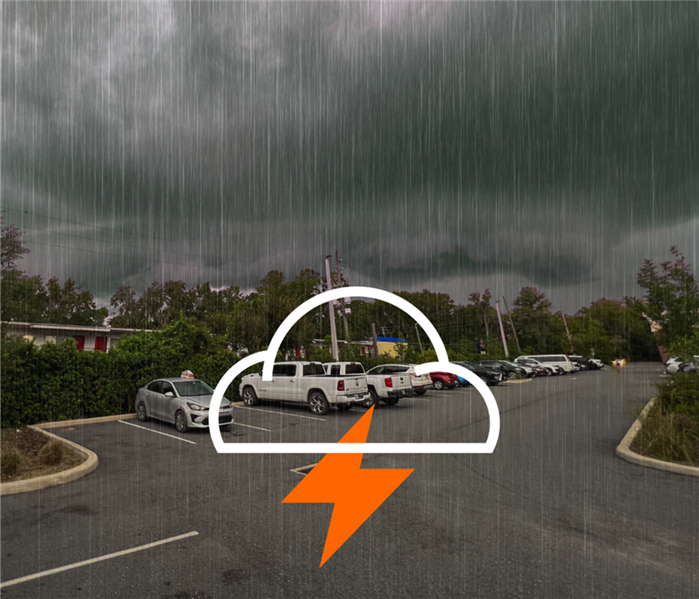 Stay prepared and stay safe during hurricane season.
Stay prepared and stay safe during hurricane season.
Living in Washington, NC, comes with its share of beautiful weather, but also the risk of flooding, especially during hurricane season. Preparing your home for potential floods can save you from extensive damage and costly repairs. Here's how you can safeguard your home and ensure your family's safety.
Develop an Emergency Flood Plan
Being prepared is your best defense against flood damage. A comprehensive emergency flood plan should include:
- Evacuation Route: Know the safest routes to higher ground or designated shelters.
- Meeting Place: Designate a safe spot where all family members can meet.
- Contact Information: Have a list of phone numbers for each family member.
- Emergency Kit: Stock up on essentials such as water, non-perishable food, medications, flashlights, and batteries.
Additionally, keep contact details for local authorities and a trusted flood cleanup agency handy.
Assess Your Flood Risk
Understanding your flood risk is crucial. Utilize online resources to check floodplain boundaries and hazard maps provided by FEMA or consult with your insurance provider for flood level information specific to your neighborhood. It’s also important to differentiate between a Flood Watch and a Flood Warning:
- Flood Watch: Indicates potential flooding, allowing time to prepare.
- Flood Warning: Signals that flooding is imminent or occurring, necessitating immediate action.
Floodproof Your Crawlspace
Proactively floodproofing your crawlspace can prevent significant damage:
- Encapsulation: Seal your crawlspace with a vapor barrier to protect against moisture and mold.
- Install a Sump Pump: A sump pump can effectively manage water accumulation in your crawlspace.
Elevate Essential Items
Raise essential items above potential flood levels to protect them from water damage:
- Outdoor Equipment: Use concrete blocks to elevate air conditioning units and other equipment.
- Indoor Furniture: Move furniture and electrical appliances to higher levels during a flood watch.
- Electrical Systems: Ensure all electrical outlets and systems are at least twelve inches above the expected flood level.
Maintain Your Property
Regular maintenance can prevent minor issues from becoming major problems during heavy rainfall:
- Clean Gutters: Ensure gutters are free of debris and direct water away from your home's foundation.
- Unclog Storm Drains: Keep storm drains clear to prevent water backup.
- Landscaping: Use native plants to stabilize soil and consider adding rain gardens or French drains to manage water flow.
Flooding can strike with little warning. By implementing these preventative measures, you can protect your Washington, NC, home from flood damage and ensure your family’s safety. Stay informed, stay prepared, and minimize the impact of severe weather on your property.
Safeguarding Your Property from Flood Damage: The SERVPRO of Bath Approach
5/16/2023 (Permalink)
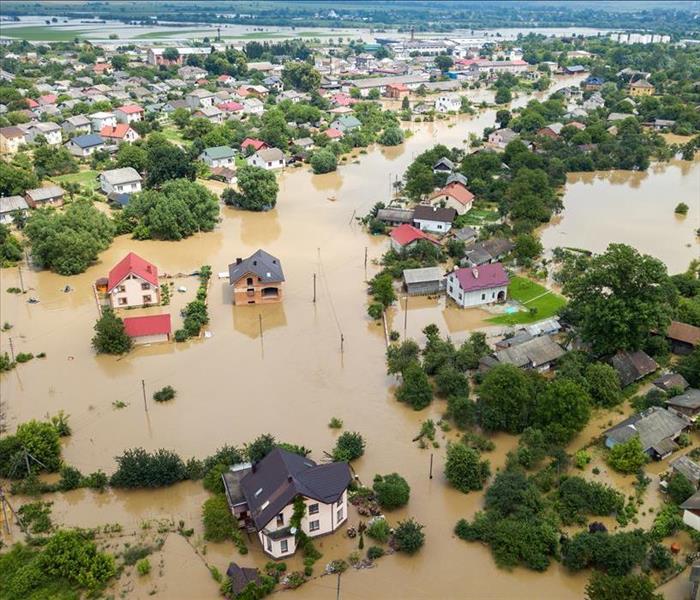 Storm season is nearly upon us. Severe weather can strike with little warning, which is another reason SERVPRO® of Bath is available 24/7!
Storm season is nearly upon us. Severe weather can strike with little warning, which is another reason SERVPRO® of Bath is available 24/7!
Floods can strike unexpectedly and cause extensive damage to both residential and commercial properties. Whether it's a natural disaster, a burst pipe, or a severe rainstorm, the aftermath can be devastating. But, there's hope. SERVPRO® of Bath offers professional, quick, and comprehensive flood damage restoration services that can help return your property to its pre-flood condition.
Understanding Flood Damage:
Flood damage goes beyond just the visible water in your home or business. It can also cause structural issues, mold growth, and ruin personal belongings. It's crucial to address flood damage immediately to prevent further complications and costs.
The SERVPRO® of Bath Approach:
While we tailor to the needs of each individual customer, we follow a systematic approach for handling flood damage:
Emergency Contact: Our team is available 24/7 to respond to your flood damage emergency.
Inspection and Assessment: We carry out a detailed inspection to assess the extent of the flood damage.
Water Removal and Drying: Using state-of-the-art equipment, we remove standing water and dry out the affected areas.
Cleaning and Sanitizing: We clean, sanitize, and deodorize all restorable items and structures damaged by the water.
Restoration: We restore your home or business to its pre-flood condition, including repairs, reconstruction, and replacing damaged materials.
Why Choose SERVPRO® of Bath?
When it comes to flood damage restoration, the expertise and promptness of the service provider matter significantly. With our quick response time, advanced equipment, and experienced professionals, we are capable of handling flood damage of any size, ensuring minimal disruption to your routine or business operations.
Remember, when a flood strikes, SERVPRO® of Bath is "Here to Help®" 24/7/365.
Water Removal After a Storm
8/23/2022 (Permalink)
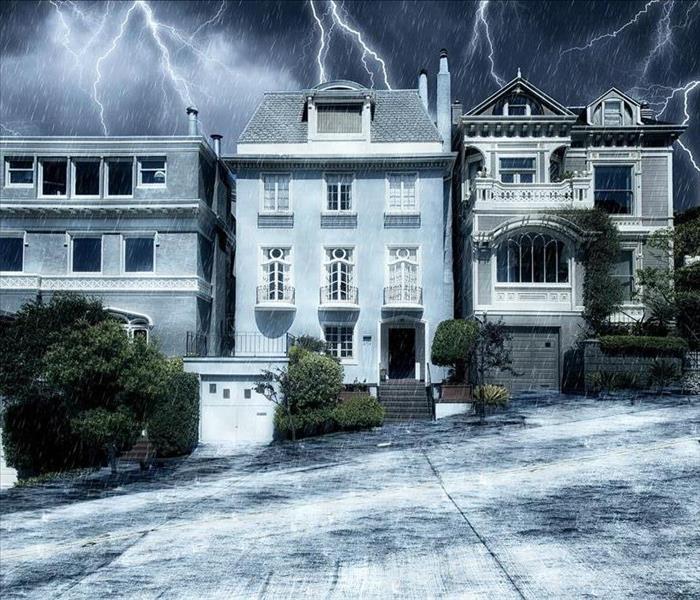 Storms and storm-related damage can be challenging to prepare for. Call SERVPRO of Bath if your home or business is unexpectedly damaged!
Storms and storm-related damage can be challenging to prepare for. Call SERVPRO of Bath if your home or business is unexpectedly damaged!
SERVPRO can't stop water from rising out of rivers and creeks, but we do have the experience and training in water removal to help you lessen the effects of flood damage. Our personnel are among the most skilled in the field of disaster restoration, and we maintain an extensive inventory of specialized equipment to return to its original state as quickly as possible.
Since water damage can occur within minutes (paper goods and some fabrics), we maintain a 24-hour removal team that can arrive as quickly as possible to begin the process. If the power has not been restored or if your electrical system has been compromised, we also have a large number of generators at our disposal so we can begin extracting.
When the standing water has been removed, there is still the problem of trapped moisture. Our recovery team will deploy equipment to forcibly circulate air through your home. Once that has started, dehumidifiers are placed in key areas to increase the effectiveness of the specialized fans. To ensure carpet pads are dried completely, we may also use a number of heaters designed to not burn carpeting. These heaters are also excellent to help prevent wood floors from warping.
Like all of the company franchises, SERVPRO of Bath is locally owned and operated. Residents aren't just our customers, they're our neighbors and family. Call us at 252-923-7205 when you need emergency assistance.
Helping Your Business After an Emergency
7/18/2022 (Permalink)
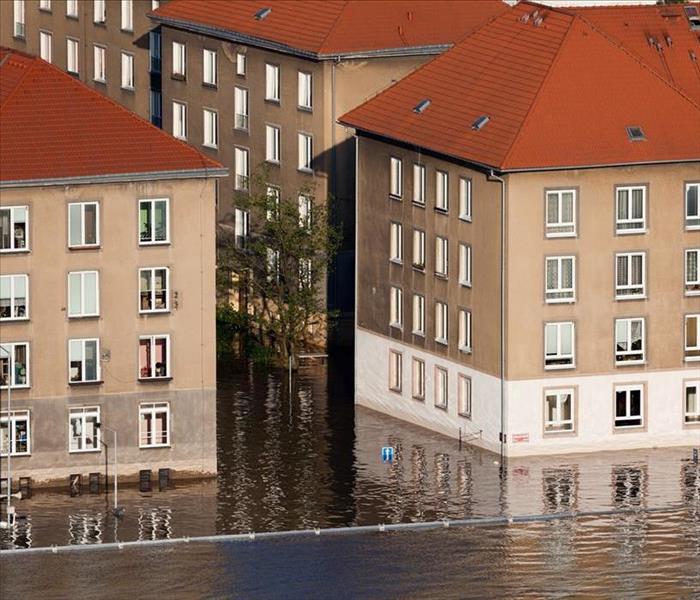 Don't let a storm or other emergency put your company under water. Call SEERVPRO of Bath today!
Don't let a storm or other emergency put your company under water. Call SEERVPRO of Bath today!
When disaster strikes your business, there are so many things to worry about. How will you be able to serve your customers? What do you do with employees who are not able to be at work? Will you have enough revenue to keep the doors open without being able to do business for who-knows-how-long? We at SERVPRO® of Bath have years of experience serving companies of all different sizes and industries. We strive to provide the best service possible, working to allow businesses to stay open or get back open as quickly as possible. Our experts know that less downtime means minimized loss of revenue for you and your company. If disaster should ever strike your business, make sure to call SERVPRO® of Bath at (252) 923-0213. We are Here to Help® you get back in business as expediently and professionally as possible.
SERVPRO® of Bath has Large Loss teams and equipment on-site, and access to an extensive network and access to over 2,000 franchises across the Nation for jobs of any size. We are dedicated to helping our customers when disaster strikes and helping to make it “Like it never even happened.” We are ready 24/7, 365 at (252) 923-0213 to help you with all your restoration and remediation needs. We are committed to serving our community when disasters such as pipe bursts, natural disasters, and fires occur.
What Is Black Water?
2/22/2022 (Permalink)
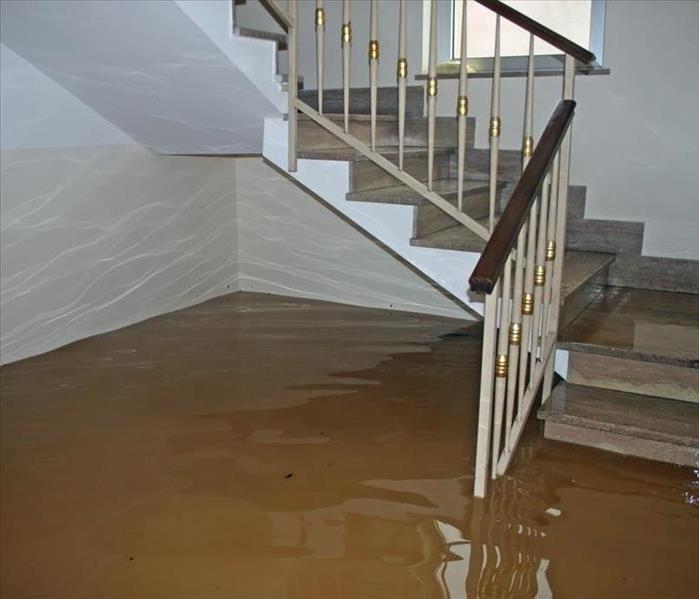 Knowing more about Black Water can help you be ready if you experience Water Damage in your Bath, NC, property.
Knowing more about Black Water can help you be ready if you experience Water Damage in your Bath, NC, property.
Many people think a flood is a flood; the water damage itself can be enough. However, a flood can be more or less severe based on the type of water present. The most contaminated water is known as category 3 or black water. It originates from water sources that are likely infested with bacteria and diseases, and/or hazardous chemicals. It could come from many different places such as heavy rains, water from overflowing lakes and rivers, seawater, sewage water and clogged drains.
How To Safely Clean Up Black Water
Cleaning up a flood of highly contaminated water requires much more than merely a mop and bucket. Although the water can cause significant damage and spread fast, you must prioritize your safety and the safety of others. Hiring flood damage restoration experts will always ensure a thorough cleanup because they have the experience and professional equipment to properly accomplish the job. Here are six steps to follow if category 3 water infiltrates your Bath, NC home.
1. Wear Personal Protective Equipment
Wearing PPE is essential for anyone in a flooded area. Everyone who is not working on the cleanup should be kept out of the affected area, particularly children and pets. This PPE can include hair covers, safety glasses, masks or respirators, latex gloves, coveralls and shoe covers. All of these items can protect the wearer from hazards in the water and air and protect the home from cross-contamination to unaffected areas.
2. Extract Excess Water
If you own a wet/dry vacuum, you already have an edge in the water removal process. Otherwise, you will need a mop or towels to remove the water. This type of vacuum will make cleanup much easier, as it quickly removes standing water and floating debris.
3. Remove Contents from Affected Area
Next, it's essential to remove as many contents as possible. Taking this action will give you more space to work. Removing all the contents will also enable you to more easily sort the unsalvageable items from the salvageable ones and clean the ones you're keeping.
4. Discard Ruined Items
The water will cause enough damage to completely ruin some things, particularly porous items like upholstered furniture and carpet. Most likely, you will find contents that have too much water damage to be saved. Others, you will not be able to clean and sanitize properly. You may even have to tear out some drywall and flooring and replace it.
5. Clean and Sanitize All Surfaces
Everything must be thoroughly cleaned and sanitized. Remember to clean all cracks and crevices, as water and bacteria can get into the smallest spaces.
6. Dry Everything Thoroughly
A mold problem can add a whole new level to the water disaster and can spread into other areas of your home. One of the most critical jobs you can do is dry the site and contents as quickly as possible. Mold can begin growing within 24 hours. Hopefully, you will never experience a flood in your home, but if you do, it's good to be prepared with the knowledge of how to mitigate the water damage by removing the black water.
How To Prevent Your Basement From Flooding and What To Do if It Does
1/20/2022 (Permalink)
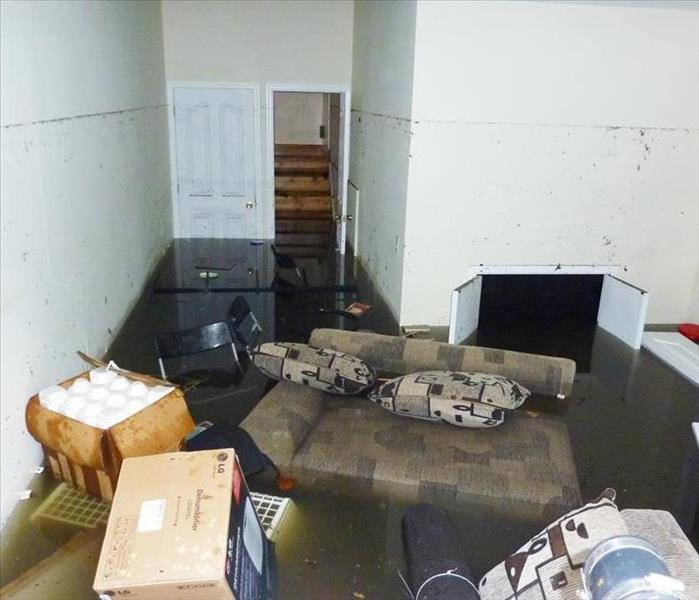 Consider these tips to better handle a Basement Flood in your Bath, NC house. If any doubt arises, please contact us.
Consider these tips to better handle a Basement Flood in your Bath, NC house. If any doubt arises, please contact us.
Discovering standing water in your Bath, NC basement can be quite a shock, especially if you had no clue that there was a risk. Several things can cause a basement flood, including heavy rainfall, a burst water pipe, an overflowing toilet, or a leaking water heater. It's helpful to have the right equipment on hand and know how to resolve the situation before a disaster happens.
This can save a lot of valuable time, and time means everything when it comes to water damage; every minute counts.
There are ways to lower the risk of a flooded basement, such as installing a sump pump and/or trash pump, making sure your plumbing is in good working order and landscaping your yard to avoid water pooling around the house.
Unfortunately, there are no guaranteed prevention strategies.
How Should I Handle a Basement Flood?
1. Shut Off the Electricity
Before you step foot into the area, shut off the electricity. Electric currents can travel through standing water, making it hazardous to step into. If you can't safely navigate to the breaker box, call the power company or an electrician to turn it off.
2. Let Fresh Air In
If the outdoor air is less humid than the indoor air, open the windows and doors and let the fresh air in to begin the drying process.
3. Extract Standing Water
Then, you'll need to extract the standing water as soon as safely possible. Using a wet/dry vacuum is the best way to safely and effectively do this. Hiring a water damage restoration company could be the best option depending on the amount of water. These companies have industrial-grade pumps and other professional equipment to deal with the water and debris.
4. Remove Everything
Next, it's essential to remove Everything from the affected area. Unfortunately, if you have carpet, you'll need to remove it and throw it out, along with padding; it won't be salvageable. You will probably also have to tear out and replace some parts of your drywall. All the contents will need to be removed to begin drying. This removal will also make room for a thorough cleanup.
5. Circulate the Air
Now, you can begin the drying process. Running fans and dehumidifiers can be a good start. You can also run portable heaters (just don't leave these unattended).
6. Clean, Sanitize and Dry Everything
Before moving everything back indoors, it's essential to thoroughly clean and sanitize the area and all salvageable contents. Then, you must make sure Everything is dry. Mold can begin growing within 24 hours if dampness remains. A mold infestation can increase the problem significantly.
Hopefully, you can avoid a significant water intrusion for as long as you remain in your home. However, now you know the risks, prevention tactics, and restoration techniques to be prepared for anything.
Knowing about home flooding and having the proper cleanup equipment ahead of time can help keep your home and family safe and potentially save you a lot of money required to return your home to its previous condition. Take these tips today to gain more peace of mind that your home and family will remain secure.
Returning to Your Home After a Flood
1/11/2022 (Permalink)
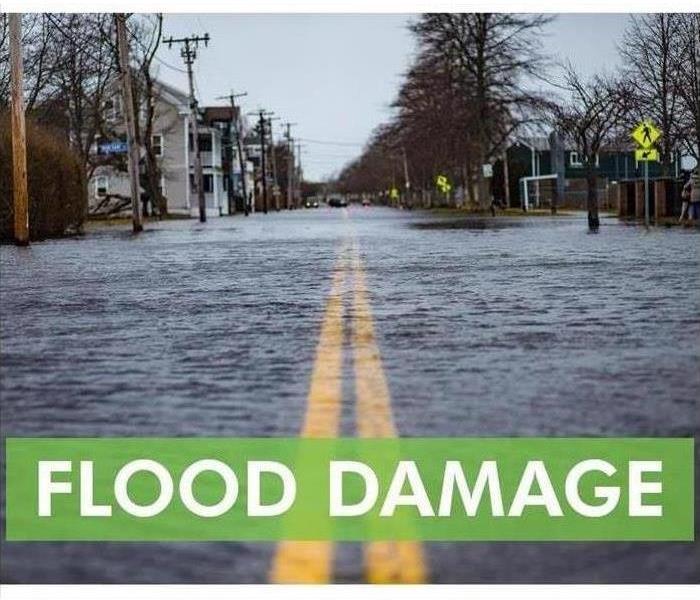 Flooding can cause severe damage to your home.
Flooding can cause severe damage to your home.
After your home in Bath, NC has been impacted by flood water, there are a variety of potential hazards that need to be considered prior to you coming back into the house.
Consider the Following Potential Hazards
Gas Leaks
- Open doors and windows to ventilate and help remove foul odors or leaking gas
- Don’t turn on any lighting, use flashlights instead
- Exit immediately if a leak is discovered and contact your service company
Electrical Hazards
- Don’t turn on lights or electrical appliances
- Turn the electricity off at the main panel before checking circuits or equipment
- Flooded basement – utility company needs to disconnect power from your house
- Have to work on live circuits (not recommended) – don’t rely on basic rubber gloves or rubber-soled footwear, only properly rated equipment is sufficient
Structural Damage
- Watch for falling debris and check for damage to floors and walls
- Knockdown any hanging plaster or drywall
- Unsure of structural damage dangers – call city building inspector or engineer
- Be aware, as water is removed, changes in pressure can cause foundation walls to cave
- Water pressure needs a chance to equalize, pump about a third of the water out each day
Drinking-Water/Food Safety
Supplies affected by flood conditions may be treated by one of the following:
- Mix teaspoonful of commercial laundry bleach with 2 gallons water, let stand five minutes before drinking
- Boil water for 10 minutes in a clean container, eliminate flat taste by shaking in a bottle, pouring from one container to another, or adding a pinch of salt
- Add five drops tincture of iodine solution to one-quart water, mix thoroughly, let stand 30 minutes before drinking
- Use water purifying tablets, available in drug stores or camping equipment outlets
- Don’t use fresh food that’s come into contact with floodwaters
Although we can't prevent floods from happening, we can certainly help with the cleanup and restoration after the waters have receded. Contact SERVPRO of Bath, we're always here to help!
Protection Against Damage When High Winds Threaten
10/26/2021 (Permalink)
 Use hurricane shutters to protect your Washington, NC, home from high winds.
Use hurricane shutters to protect your Washington, NC, home from high winds.
The time to purchase hurricane shutters is long before high winds lead to a hurricane warning. Once the warning arrives, you may have less than 36 hours to prepare, and it may be difficult to find storm shutters when everyone else is also scrambling to get them to protect their Washington, NC, homes.
Protect Your Home From High Winds
Of course, hurricanes aren't the only type of storm that brings powerful winds, and these storms often mean flooding, thunder, lightning, extreme temperatures, and even wildfire. Every step you take to protect your home is a vital part of surviving and recovering from storm-related damage. Here's a closer look at preparing for strong winds:
1. Check Your Exterior Property
Look around your yard and take stock of your belongings. Do you have furniture, toys, and tools that could be thrown around by the wind? Those items can cause a lot of damage when they are flung against your home, your car, or your neighbors' properties. Avoid this trouble by providing a secure storage location where you can quickly secure your outside possessions.
2. Storm-proof Your Landscape
Weak branches and landscape rocks become projectiles during high winds. Consistently clear out rocks, loose debris, and fallen branches from your yard. Check trees and shrubs for evidence of weakness and have them pruned regularly to keep them healthy. You may even want to talk to neighbors if there are potential hazards in their yards.
3. Protect Your Roof
The large, exposed surface of your roof is easily damaged during storms. One of the best ways to prevent serious harm is to schedule yearly inspections, maintenance, and repairs. If there are loose tiles or shingles, gaps between materials, or weakened areas, your roof may expose the rest of your home to damage. Consider the addition of roof strappings for added protection against wind.
4. Protect Windows and Glass Doors
Storm shutters are one of the best types of protection. There are several varieties, including aluminum accordion, roll-up, roll-down, and Bahama shutters. Each option has pros and cons, including pricing and installation considerations. It's best to talk through your options with experienced professionals in Washington, NC. You can also decrease potential damage by adding shatter-resistant film.
5. Reinforce Doors and Garage Doors
Many garage doors, in particular, are susceptible to powerful bursts of wind. Use girts to reinforce the door itself and then strengthen wheel tracks. Other doors throughout your home can be secured with heavy-duty deadbolts, using slide bolts and long hinge attachments for increased security.
6. Maintain Your Home
Routine maintenance solves a lot of problems and regularly prevents expenses for storm and water damage cleanup. As part of your routine care, make sure that all cracks and gaps are sealed to keep wind, water, and debris away from vulnerable areas of the home. Use a waterproof sealant and make sure that all holes, especially around wiring and pipes, are tightly sealed.
There are many steps you can take to mitigate storm damage. Get more information about preventing property damage from high winds by talking to your insurance company, property damage experts, and your local planning and zoning department.
Minimize the Damage Caused by Flooding
8/26/2021 (Permalink)
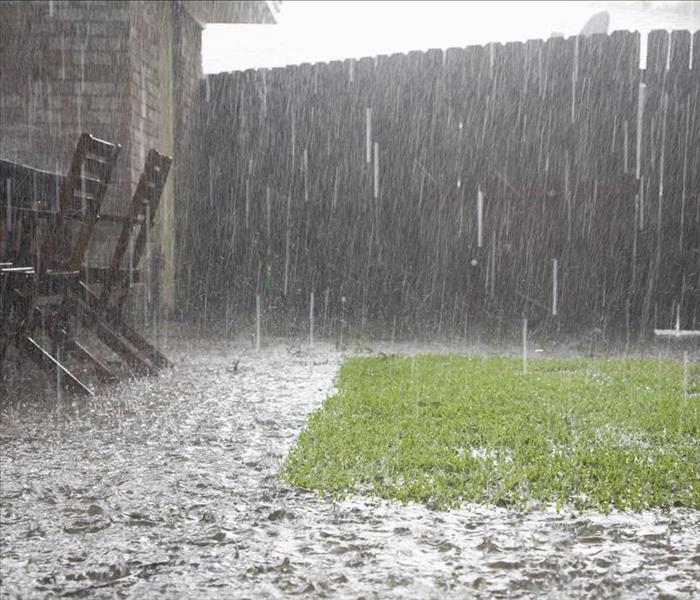 Take some fundamental steps to reduce the flooding damage in your Washington, NC, home.
Take some fundamental steps to reduce the flooding damage in your Washington, NC, home.
If your Washington, NC, home is situated in a part of town where flooding is a threat, it's important that you know the steps to take to minimize flood damage. After all, these situations are some of the most common and most expensive disasters to face homeowners, especially when caused by flash floods.
- An emergency flood plan should include:
- An evacuation route
- A meeting place
- Contact information for each family member
- A well-stocked emergency kit
It's also a good idea to have community resources available. The numbers of your local authorities or a flood cleanup and repair agency can be helpful.
Understand Your Flood Risk
Some communities offer information online where you can check for floodplain boundaries. You may find flood hazard maps on the FEMA website, or you can reach out to your insurance provider to learn more about the flood level in your neighborhood. Make sure you know the difference between a Flood Watch and a Flood Warning.
A Flood Watch means that you have time to prepare to evacuate, but you may not need to leave.
A Flood Warning, on the other hand, means that water is already on its way, and you need to act immediately.
Floodproof the Basement
Before there's any hint of a storm and potential flooding, take steps to prevent flood damage. The basement is one of the areas in your home that's most likely to be affected. You can prevent a lot of damage by using a concrete sealant on the floors and walls to protect the structural stability of your home. The sealant also protects against mold, mildew, and other effects of high humidity. Depending on the risk, adding a sump pump can be beneficial.
Raise Belongings Above the Flood Level
Use concrete blocks to raise air conditioning units and other outside equipment above flood levels. If your area is under a flood watch, move as much furniture into the upper levels of your home as possible. Waterlogged electrical outlets and other sources of electricity can pose many dangers. Move all electrical units at least twelve inches above the flood level. You can reduce the expense of replacing furniture and belongings and avoid hiring water damage cleanup and repair professionals by keeping your valuables above the estimated water level.
Use Maintenance and Landscaping
Even a relatively small event can lead to storm damage. For example, if your gutters and storm drains are clogged with leaves and debris, heavy rainfall can lead to interior and exterior damage. Completing routine maintenance around your property can save you from a lot of trouble:
- Keep gutters clean and flowing away from the foundation of your home.
- Prevent trash from clogging your storm drains.
- Introduce native plants to your landscape to hold the soil during flooding.
- Add a rain garden, French drains, or additional features to provide a way for water to flow away from the house.
Flooding doesn't always provide much warning before it hits. Make sure that you're ready for this type of disaster before there's any sign of rain. Use these tips to protect your Washington, NC, home.
3 Tips for Cleaning After a Flood
7/22/2021 (Permalink)
 Cleaning after a flood it's necessary to avoid other serious damages.
Cleaning after a flood it's necessary to avoid other serious damages.
If your property has been damaged by a home flood, prompt cleanup is essential for preventing additional damage, such as mold, mildew, or rot. These three tips can help you get started.
1. Stay Safe
Floodwater often contains contaminants and can pose an electrocution or drowning hazard. Always check with local authorities before attempting to enter a flooded home. Have the power and gas service to your home shut off and avoid entering if there are any power lines down in the area. Wear protective clothing or contact a professional restoration company in Washington, NC, to ensure safety during the cleaning and drying process.
2. Remove Wet Materials
Drying out your home as quickly as possible is essential for avoiding mold growth. Remove wet carpet, furniture, and bedding within 24 hours of a home flood, if possible. Keep the damaged contents on site until your insurance adjuster has had a chance to look at them. Carpets, rugs, carpet pads, upholstered furniture, and mattresses will usually need to be replaced. Discard food items, other than commercially canned products that may be salvaged if the labels are removed and the cans are cleaned and sanitized.
3. Prepare the Site for Cleaning
When floodwater from storm damage recedes, it often leaves silt and mud behind. Remove this with a shovel and then wash hard surfaces with a water hose. Wood floors and subfloors exposed to water will likely need to be removed. Flooded walls should be opened to prevent mold growth, decay, and odors in the wall studs. Pump water out of your basement gradually. Use fans and dehumidifiers and open windows and doors to help with the drying process.
While it is important to wait until it is safe to attempt to enter a structure after a home flood, quick action is necessary to reduce additional damage. Contact your local authorities and insurance professional for additional guidance on the cleanup and restoration process.
The Flood Restoration Process
5/28/2021 (Permalink)
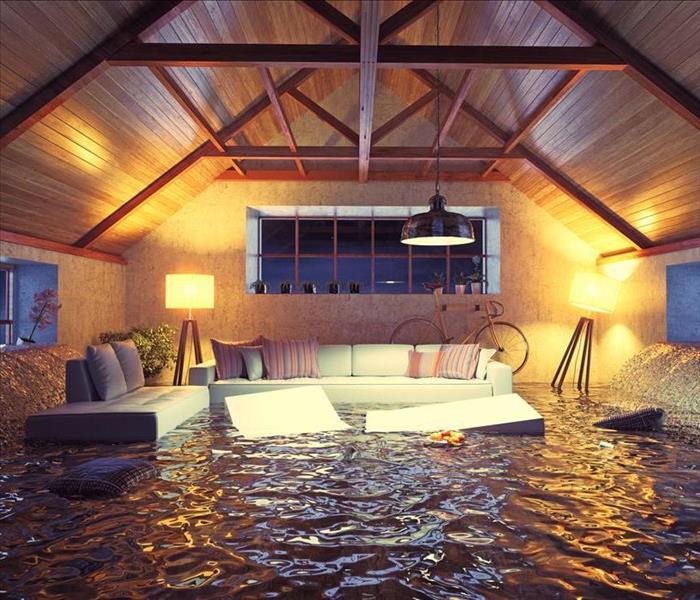 Flooding after a storm can lead to severe damage if not treated quickly.
Flooding after a storm can lead to severe damage if not treated quickly.
Severe storms can often lead to flooding, which can become significant depending on the duration of the adverse weather. Interior flooding of a residence can result in significant damage and property loss. However, with a quick response from an appropriate water restoration service in Washington, NC, the damage can be reduced and reversed. These companies specialize in a four-step restoration process that ends with you, the homeowner, getting to return to your property.
4-Step Restoration Process
1. Water Removal and Tear Out
Before the restoration team can begin any cleaning or repairs, they must first remove the excess water. Depending on the category of the water, precautions might need to be taken. However, despite any extra safety measures, the crew will still likely use pumps and shop vacs to remove the water.
With the water removed, the team can begin the tear out part of the process, including a flood cut. The flood cut is a cut made about 12 to 18 inches above the flood line. By opening up the walls this way, the crew can remove water-damaged materials, like insulation.
2. Drying Out the Affected Areas
With the walls open, the restoration team can begin drying the house from all the flooding. They will use fans, air movers, and dehumidifiers to help expedite the drying process. It is crucial to dry the house as quickly as possible to reduce the risk of mold development.
3. Cleaning the Property
To rid the house of any contamination from bacteria or other elements in the floodwater, the crew will get to work disinfecting and cleaning the property. They will use commercial cleaners and disinfectants, and might even reclean the house to ensure everything is safe to touch.
4. Restoring To Pre-Disaster Condition
With the cleaning out of the way, the crew can begin repairing any structural damage. Once the structural issues are corrected, they can restore the property cosmetically, ensuring the house looks like the home you remember.
Flooding is devastating, and the recovery process can be too much for most homeowners. Just know that the right professionals can restore even the most damaged property.
Encapsulation: Your Solution to Crawlspace Humidity
2/24/2021 (Permalink)
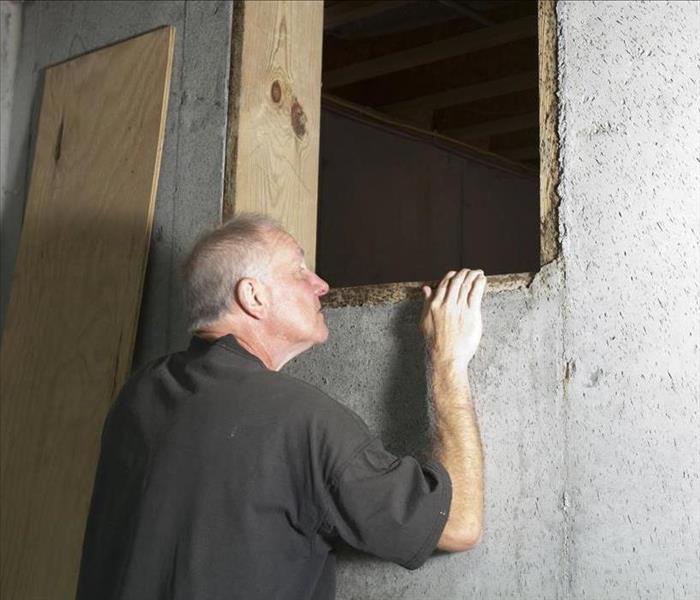 Crawlspace humidity is a common problem.
Crawlspace humidity is a common problem.
Is there a crawlspace under your home? Whether it's full of random storage items or left empty during the year, it's also part of your home that plays an important role in supporting the structure of your home. Sadly, crawlspace humidity is a common problem that exposes the foundation to mold and rot unless you take preventative measures.
Encapsulation
What Benefits To Expect
Encapsulation is an effective method of protecting the open area below your home. Crawlspace humidity creates an inviting environment for mold but sealing the space or installing a vapor barrier of polyethylene keeps moisture out. While many Washington, NC, homeowners still haven't heard of this protective step, there are several benefits:
- This airtight barrier is also resistant to insect infestations and other pest-related problems.
- Encapsulation may reduce the amount of energy by almost 20 percent.
- The sealed space improves your ability to maintain temperatures in your home, effectively reducing your utility bills.
- Your property value may increase.
- Combine this step with a dehumidifier and the right amount of ventilation to avoid expensive repairs related to moisture and mildew.
With the heavy-duty barrier in place, you can feel confident that your home is protected against expensive water damage.
How To Tell You Need Services
How do you know if your Washington, NC, home needs this type of protection? There are several signs that the empty space below your home is causing trouble:
- Musty smells from the empty space
- Floors that feel squishy underfoot
- Constant pest problems you can't control
- High utility costs in spite of home improvements
- Visible evidence of moisture around windows or on ductwork
As humidity builds up below your home, the effects are easily recognized. It's best to take action before you need to call in water damage repair experts.
When To Get Started
Crawlspace humidity is a significant cause of home damage. Adding a polyethylene barrier prevents damage to the foundation and the rest of the home. If you haven't considered this solution, now is the time to give it some thought.
How To Respond to Roof Damage
1/27/2021 (Permalink)
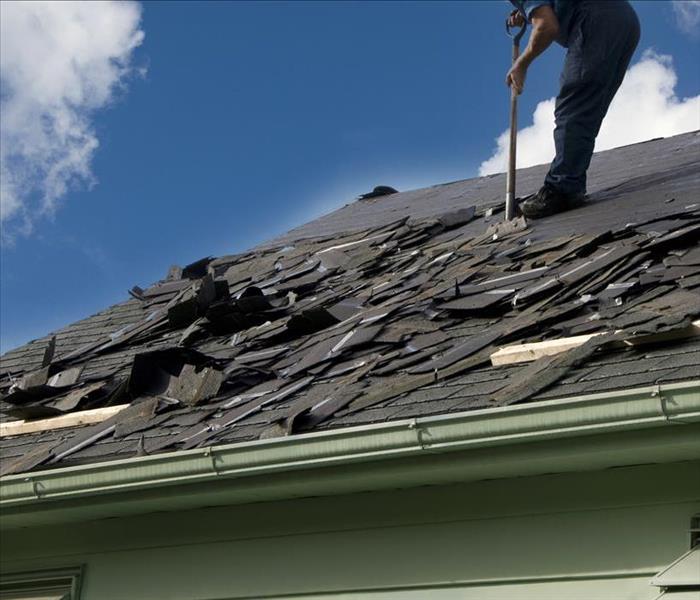 Severe storms can lead to roof damage.
Severe storms can lead to roof damage.
If your Washington, NC, home has suffered roof damage because of a severe storm, you may wonder what the next step is. Once you take steps to repair damage, how can you prevent further damage from happening? Before you prop a ladder against your home, it's best to contact roof repair and mitigation professionals to ensure you're on the right track.
Do you need mitigation services?
Mitigation steps are some of the most important you can take. This is because the goal of mitigation is to prevent existing damage from becoming worse as well as avoiding future damage if possible. How do you know if you need mitigation services?
- Shingles are missing
- Roofing materials are cracked
- There are holes in the roof
When you first notice damage, you can use tarps and boards to provide a temporary solution. However, climbing onto a wet or damaged roof can be dangerous. Be sure to think logically before putting your health at risk.
What can you expect during roof repair services?
When roof repair professionals arrive to address roof damage, they'll probably take a few steps right away:
- Conduct a thorough inspection of water and wind damage.
- Put up temporary tarps and boards to keep more water and debris out of your home.
- Conduct an inspection of damage from within your home.
- Prepare a plan for completing cleanup, restoration, and mitigation.
Although professionals may be ready to complete the bulk of the work, there may be tasks you can do as well. Technicians may provide suggestions for the work you can do as well as steps you can take to avoid damage in the future. Your insurance provider may be another good source of clean up and prevention advice.
A quick response is the best way to prevent further damage and to keep costs as low as possible. When your home has suffered from roof damage, act immediately to get mitigation and repairs moving.
Be Prepared for Freezing Temperatures & Frozen Precipitation
1/20/2021 (Permalink)
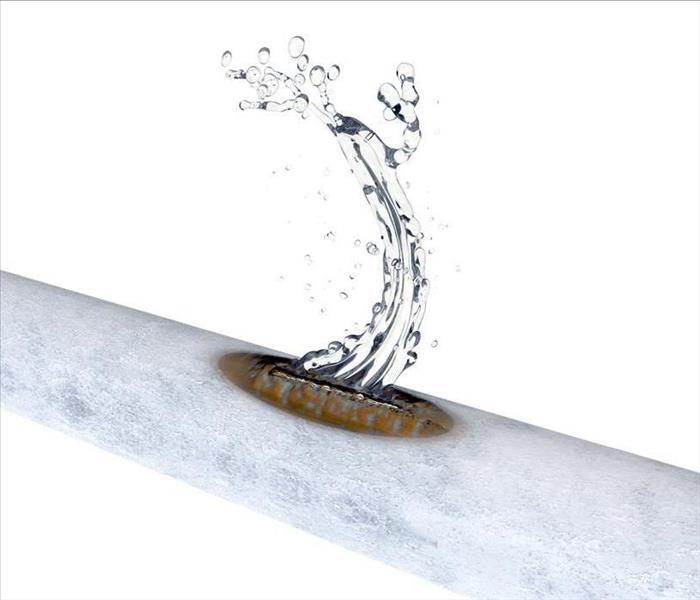 Frozen pipes can cause severe water damage
Frozen pipes can cause severe water damage
Although the weather has been warm, we still have a lot of cold weather ahead of us. Eastern North Carolina still has several months where the temperatures will most definitely go below freezing. Water is definitely a necessity, but frozen water can cause severe damage to homes and businesses. Water is unique in that it expands as it freezes, thus causing plastic and metal to break.
Common issues with pipes that are prone to freeze are:
- Water supply pipes in unheated interior areas such as crawl spaces, basements, attics, garages, or kitchen cabinets.
- Pipes that run against exterior walls and have little or no insulation
- Pipes exposed to severe cold, such as outdoor hose bibs, swimming pool supply lines, and water sprinkler lines.
Several Ways to Prevent Frozen Pipes
- Try keeping your thermostat at the same temperature day and night.
- Consider setting your temperature at 55* if you are going to be away from your home during a cold snap.
- If you have supply lines in your garage, keep the doors closed.
- Open kitchen and bathroom cabinet doors to allow warmer air to circulate around your plumbing if they are prone to freeze
- Let cold water drip from faucets which have exposed pipes.
We hope these tips will help you avoid frozen pipes. However, if you notice damage from frozen temperatures as things begin to thaw out – react quickly and call SERVPRO of Bath. Remember, frozen pipes can quickly cause a lot of damage to your property. If and when this happens, give us a call, we’re here 24/7 and can make it, "Like it never even happened."®
Always Have a Plan when the Storm Hits
12/14/2020 (Permalink)
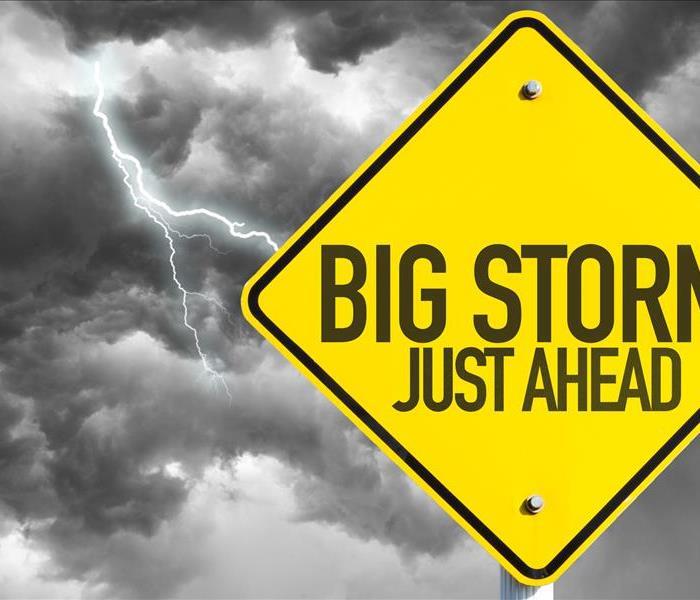 Prepare your building before big storms hit.
Prepare your building before big storms hit.
When your business is in danger from a storm you can’t afford to risk your investment to water damage from a flooded building. Prepare your commercial property for an oncoming storm and minimize the damage as much as possible.
5 Steps to Prepare Your Commercial Property For Oncoming Storms
- Have a Plan
Your first priority should be to have a plan set for when a disaster hit. This plan needs to have clear steps to outline what to do in an emergency. The plan should include how to protect your building’s structure which may include boarding up windows or cutting back trees, how to safeguard your equipment by placing everything off the floor, and the first steps of how to recover by pumping out water and removing wet materials.
- Protect Your Investment
Be ready to minimize damage with weatherproofing. This can include sandbagging the exterior of your building, installing weather stripping, moving your equipment and inventory to higher ground, and sealing any leaks. Minimize as much damage as possible by preventing stormwater from intruding on the building.
- Make Backups
One of the most important things you can do is back up your business data. You always want to have a few different ways to back up your office information.
- Know Your Evacuation Routes
When the storm comes, your first instinct may be to stay as long as possible to ensure your building is appropriately protected. Instead, you should be focusing on safety. Lost inventory, equipment, and data can be recovered.
- Have your insurance information at hand and know the process to file your claim.
Every insurance policy is unique. Check to see if you have a flood policy. Even if you are not in a mandatory flood insurance area, consider getting the insurance since we do live in a flood prone area. Do you have adequate content coverage? Loss of business income coverage? Work with your insurance professional, be sure you have all your bases covered well in advance of a storm.
Here at SERVPRO of Bath, we have cleaned up after many storms in our area. We also are unlimited licensed builders with over 40 years experience to repair your building. You focus on safety, and we will take care of the rest.
Hurricane Preparedness 2020
6/15/2020 (Permalink)
Every household should have an emergency plan in place to make sure they are ready when disaster strikes. Although they don’t happen every day, you need to be prepared when they do.
The best way to be ready for a disaster is to make an emergency preparedness kit. This kit is full of essential items that you would need to survive for a minimum of 72 hours if disaster strikes. Some items you need to consider adding to your emergency kit include the following:
Water: Water is the key to survival! You will want to have 1 gallon of water per person, per day for at least 3 days.
Food: Along with water, in order to survive you need food. When packing food be sure to pack non-perishable items in your kit, such as canned foods. You should have at least enough food for 3 days, but more is always better.
Can opener: As noted above, canned food is non-perishable – so packing a can opener may not be as random as it seems.
Flashlight & Batteries: When the powers goes out, you don’ have lights. Having a flashlight and extra batteries will help brighten up the dark nights.
Battery Powered or Hand Crank Radio: Having one of these on hand will help keep you informed and updated during a storm or disaster situation.
A First-Aid Kit : Having one of these will help you be prepared if someone gets injured. Common items such as band aids, Neosporin, and gauze could really come in handy.
Matches or a lighter: Packing matches or a lighter along with an emergency slow-burning candles can be a good alternative to a flashlight. Having a candle gives you an additional light source during a storm.
Whistle: This is meant to be a signal for help; three blasts from a whistle is an international distress signal. The best place to keep this is on your keychain or taped under a table in your home for quick easy access.
Cell Phone with Chargers and a Backup Battery: In today’s age of technology, we rely heavily on our cell phones to communicate with friends or our family. Having a backup battery reassures you that even if the power goes out, you can still use your phone to communicate.
All of these items are essential to your survival during a storm or disaster. Every household should have an emergency preparedness kit ready before we ever have to worry about a storm. Make sure these items are placed in an easy-to-carry container and are labeled. Place your kit in a convenient location, one that is easy to reach when you need it.
In addition to these items, it’s also important to think about where you live and what other items you may need, such as medications, infant formula, diapers, wipes, bottles, and pet food/water.
Don’t forget, it’s never too soon to buy emergency supplies and prepare for a disaster. Natural disasters can happen at any time and affect people all around the world. You should prepare your home just like you are preparing your emergency kit. At SERVPRO of Bath, we have over 40 years of experience repairing damage if you need us. When disaster strikes, your focus should be on safety. We’ll take care of the rest.
Why Do You Need Renters Insurance?
6/15/2020 (Permalink)
As we move into storm season, there are several reasons to consider a policy today.
It’s a fact that over 90% of homeowners have an insurance policy on their home however, believe it or not, less than 40% of renters have renters insurance. When a landlord owns the building or home you are living in, the home owner will most likely ONLY have insurance for the structure but not what is inside. Unfortunately, your landlord’s property insurance will not help you if a disaster were to strike.
During storm season it is particularly important for you to talk to your landlord and find out what type of insurance they have on the property and what that covers. If their insurance does not include coverage for your belongings, you may need to speak with an insurance agent.
Here are a few reasons you should have your own renters insurance:
- If you have personal belonging that have been damaged or stolen, a basic renters insurance plan will reimburse you for those items.
- Damage caused by a fire or flood will be covered by a renter’s policy.
- If the home or apartment you are living in is severely damaged, and is not livable, an insurance plan will pay or help you pay for other living arrangements.
You may not be a homeowner, but renters insurance provides you with many of the same protections that may be beneficial in the event of an emergency such as a fire or storm damage from a tropical storm, hurricane or associated flood waters. You should talk to your insurance agent, there are plans available that can sometimes be as low are $12 a month.
If the home or apartment you live in is damaged due to a storm or fire, the professionals at SERVPRO of Bath will work with your insurance company so you can get the relief you need. We hope you never need us, but if you do we can be reached at 252.923.0213.
Get the Scoop on Water Damage Remediation Before It’s Too Late!
4/24/2020 (Permalink)
Many homeowners recognize the role dehumidifiers play in drying out homes or businesses damaged by storms, but there are few who really appreciate why dehumidification devices are necessary in water loss recovery. Our trained SERVPRO team can implement containment barriers isolating damp areas of your home to create a space where we can monitor airflow, drying, and structural integrity of the affected areas of your home.
We have machines of different size and types therefore it makes sense that there are different ways that those machines can help in removing water damage. Depending on the type of moisture present, our technicians can decide which equipment would be best used and necessary for each project.
Containment
Containment is key to helping moisture removal practices be more productive and it can also intensify the production of running dehumidifiers. In an enclosed space, units are recirculating the same air, which allows it to dry quicker than if we were to use open-air.
Evaporation
Air movers are used by our team to vaporize moisture in materials throughout a home, this vapor suspends as cool air just above the surface of the wall or flooring. These cooler temperatures can slow the drying and restoration process, which makes the abilities of dehumidifiers valuable.
Drying Balance
Establishing the correct balance of air movers and dehumidifiers is just one of the many things the SERVPRO of Bath team faces with water mitigation projects. If there’s too much evaporation, the dehumidifiers can’t keep up. This is also true about the position and placement of the two to help maintain a balanced drying system. At no point should the amount of moisture drop below the moist air created through evaporation.
No matter how severe the water damage to your home or business is after a storm, we can help. We have dehumidifiers in many sizes and strength to tackle the hardest jobs. Give us a call today at 252-923-0213 if we can help.
Winter Storm Help - Be Prepared
2/9/2020 (Permalink)
Winter weather in North Carolina can be very unpredictable. Although snow has not been in the forecast yet this year, it can prove to be beneficial to make sure your home, car and any other surrounding areas are ready for any impending storm. Here are a few helpful tips for homeowners;
Salt the pavement around your house: although the city is pretty good with clearing the roads around your home, the sidewalks and pathways are left up to you to clear them. To make things easier on a homeowner, once you know that a storm is headed your way, you can spread salt on your driveway and walkway. If you place salt down prior to a snowstorm, you can reduce the ice that forms underneath any piles of snow.
Keep a steady drip in your pipes. With snow comes freezing temperatures and this leaves your pipes vulnerable. And, if they freeze, they can definitely burst. If you have a subtle but steady drip of warm water running through the pipes, it will help keep your pipes from freezing during these conditions.
Don’t forget to create a winter ready emergency kit. If you have a storm, you never know the strength of it so you need to make sure you keep you and your family safe. You can do this by creating and keeping a winter ready emergency kit on hand. Just a couple things to keep in the kit are bottled water, batteries, a functioning radio, different types and layers of clothing, blankets and nonperishable food items.
SERVPRO of Bath has a 24/7 emergency response team that is well-versed to handle all storm damage in Beaufort County. We’re here for your emergency for both residential and commercial properties in the area.
Let a Disaster Remediation Company Improve the Mitigation Process
1/2/2020 (Permalink)
When customers have flood, fire or storm damage their personal or commercial property in eastern North Carolina, they often turn to us as a knowledgeable and reliable restoration company. They know we’re always here when they need us. Our service team is available 24/7 because we know that is important when managing the restoration process and saving your personal or business items.
Here are three ways a professional disaster remediation company can improve the mitigation procedure with a quick response.
- Timing Is Essential to Minimal Damage and Loss
When the initial call is made, the disaster team must be able to move quickly because decisions about the scene, water removal, and area restoration often require quick and comprehensive decisions. You will want a restoration service that responds to your call as soon as possible. You don’t want to try and handle the job on your own and make matters worse. By calling a restoration company that offers immediate on-site response with certified technicians, you’ll know you’ll receive up-to-date reports on the status of the job soon after the process begins.
- Quick Mitigation is Imperative
A quick response is important, but so is mitigating the standing water at disaster scene. Experienced restoration and remediation service personnel understand that they have a 24-hour window before mold and mildew often begin growing in the wet environment. Immediate mitigation at the scene can help prevent the growth of mold which causes more damage.
- Restoration is Vital
Once the water has been removed, the restoration process can begin. Repairing an area can be less expensive than removing and rebuilding, so it is important to dry the area out quickly and begin the initial site assessment to look for further damage. We know our clients depends on us as a quick, reliable restoration team.
Hiring a knowledgeable team with 24/7 availability allows home and business owners to prevent further damage and get back to work as quickly as possible. Call SERVPRO of Bath and let us help.
When a Storm Hits, SERVPRO of Bath is Ready to Help You!
12/1/2019 (Permalink)
SERVPRO of Bath specializes in storm damage restoration. We utilize the latest techniques and cutting-edge equipment to get your home back in preloss condition as soon as possible after a flood or storm.
Locally owned and operated, we are able to respond quickly and efficiently. A fast response lessens the current damage, limits further damage and reduces the overall restoration cost. Storms don’t wait for regular business hours and neither do we. Our technicians will respond day or night to help local business owners and residents.
When disaster strikes, we can scale our resources to handle a large storm or flooding. SERVPRO of Bath has access to equipment and personnel from a network of 1,700 franchises across the country and elite Disaster Recovery Teams that are strategically located throughout the United States.
Have storm or flood damage? Call SERVPRO of Bath today at 252-923-0213.
Avoid These Common Mistakes Following a Flood
12/1/2019 (Permalink)
While severe flooding from a storm can destroy your house, even minor house floods can cause widespread damage – if you’ve experienced a flood, it’s crucial to take steps right away to deal with the aftermath. The wrong course of action could lead to further damage and costs. Here are some helpful hints to avoid common mistakes people make following a flood:
1) Wear Proper Protective Clothing
• knee-high rubber boots
• latex gloves
• disposable N-95 face mask
2) Stay out of the water, it will likely contain bacteria, microbes and other harmful material.
3) Don’t let the water touch exposed skin, you could become seriously ill; and worse, if ingested, it could be fatal.
4) Don’t delay cleanup, contact your insurance company then restoration professional SERVPRO of Bath, 252-923-0213, immediately.
A Brief Overview of Flood Restoration Services
12/1/2019 (Permalink)
Water is a basic need for humans; however, it can be a destructive force that presents serious threats to your property. It’s important that homeowners affected by storm flooding obtain professional flood restoration services.
A major side effect of flooding is the growth of mold, which thrives in humid, damp conditions. Flood restoration specialist SERVPRO of Bath can eliminate mold issues by offering detail-oriented, drying services.
We can also help prevent damage to your home's electrical systems, when exposed to water they can begin to malfunction. It’s critical that homes impacted by flood waters be dried out as quickly as possible to prevent fire or electrocution.
If flooding has damaged your property, professional flood restoration services are a must. Contact the experts at SERVPRO of Bath, we utilize the latest techniques and cutting-edge equipment to get your home back in preloss condition.
Call today to learn how SERVPRO of Bath can help restore your home after a storm and flooding, 252-923-0213.
Freezing Temperatures in Eastern NC
1/3/2019 (Permalink)
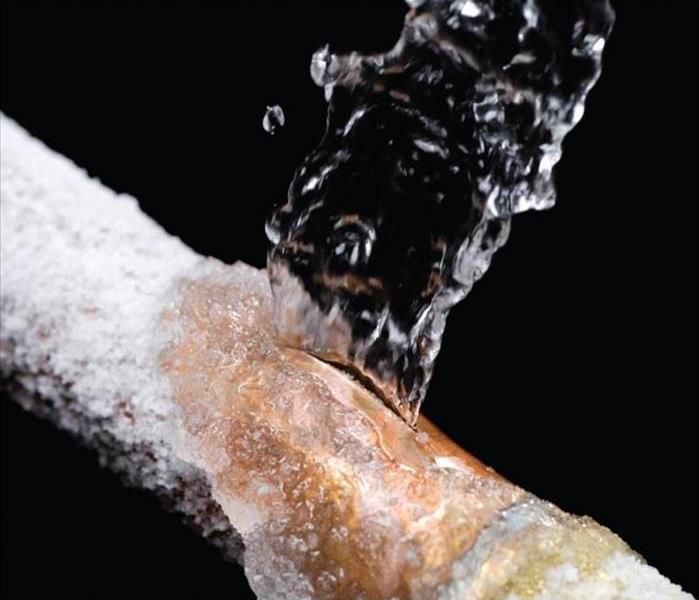 A single pipe busting can cause a great mess
A single pipe busting can cause a great mess
Weather forecast for Eastern North Carolina predicts freezing temperatures in January-February 2019! Water is one of life's necessities, but frozen water can cause major damage. Water's unique property to expand as it freezes can cause metal or plastic pipes to break.
Pipes that Freeze Most Frequently
- Pipes that are exposed to severe cold, like outdoor hose bibs, swimming pool supply lines, and water sprinkler lines.
- Water supply pipes in unheated interior areas like basements and crawl spaces, attics, garages, or kitchen cabinets.
- Pipes that run against exterior walls that have little or no insultation.
How to Prevent Frozen Pipes
- Keep garage doors closed if there are water supply lines in the garage.
- Open kitchen and bathroom cabinet doors to allow warmer air to circulate around the plumbing.
- Let the cold water drip from the faucet served by exposed pipes.
- Keep the thermostat at the same temperature day and night.
- Set the temperature at 55* if you are going to be away during cold weather.
Hopefully all your efforts to avoid frozen pipes will be successful. BUT is not, you will know it when the pipes begin to thaw! Frozen pipes can quickly cause a lot of damage to your property. When and if this happens, call SERVPRO of Bath 24/7. We can make it, "Like it never even happened®."
Emergency Kits for Natural Disasters
6/24/2018 (Permalink)
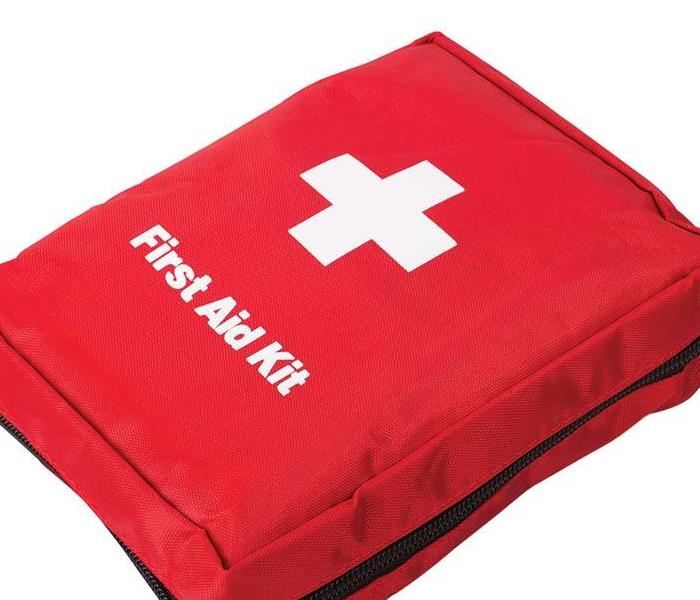 Be Prepared!
Be Prepared!
First aid kits, or emergency kits, are too important to put them together when a disaster strikes. Natural disasters usually happen suddenly, and kits need to be ready to go at a location near the door so you can focus on the safety of your family or personnel first.
Below are examples of what to include in your emergency kit.
What to Include in a kit for a group of 2 to 3 people -- Medical items to keep in a first aid kit include the following:
- Gloves
- Adhesive bandages
- Gauze pads
- Equipment for resuscitation
- Splints
- Towelettes to clean wounds
- Scissors
- Tweezers
- Emergency blankets
- Adhesive Tape
- Rope
- water bottles or packets
- three days of food/snacks (MREs)
- Change of clothing
- Radio
- games to pass time
- Paper/Pen
- Important papers
Place kits in a location that are easily accessible. Contact your local Red Cross for more information on how to be ready for a natural disaster.
What you need to know about Storm Damage
5/24/2018 (Permalink)
Living in Eastern NC, storms are a a way of life. Flood damage, wind damage and wind driven rain can permanently damage your home if not restored properly.
Wind Damage- When a storm hits your home and/or commercial building most likely wind will be involved. Winds can cause roof damage, fallen trees, wind-driven and broken windows. A professional should be in a place to offer solutions to any wind damages sustained to your home.
Ground Water- During a storm the ground looses its ability to drain all the water. When this happens dirt and soil become soft and start to float along with the water. When storm water sits, it starts to carry debris and become a health concern due to the diseases it can carry. For faster drainage, call a SERVPRO. Mold starts forming in 48-72 hours, so time is of the essence to drain water, remove wet materials and dry out the building to reduce damage and lower costs of repair.
Hail Damage- Hail can cause severe damage to roofs, siding, stucco, windows, and doors. Water can then penetrate your home which allows moisture and mold to cause further damage.
When it comes to any storm damage keep SERVPRO of Bath in your mind. Our crew and office staff our here to help you walk through your damages and it will be “Like it never even happened".
When the storm hit Windsor, NC, unfortunately they were hit with flood waters back to back in two weeks. SERVPRO of Bath was there as soon as the waters receded both times to quickly remove the wet materials and begin the drying process.
Hurricane Irene in 2011 caused a tremendous amount of damage in our area. Here at SERVPRO of Bath, we do our best to let you know when we can arrive at your home any time day or night.
SERVPRO of Bath understand Eastern, North Carolina because we are locally owned but have national support in case of emergencies. We hope you will call us at 252-923-0213.
When Storms or Floods hit, SERVPRO is ready!
5/11/2018 (Permalink)
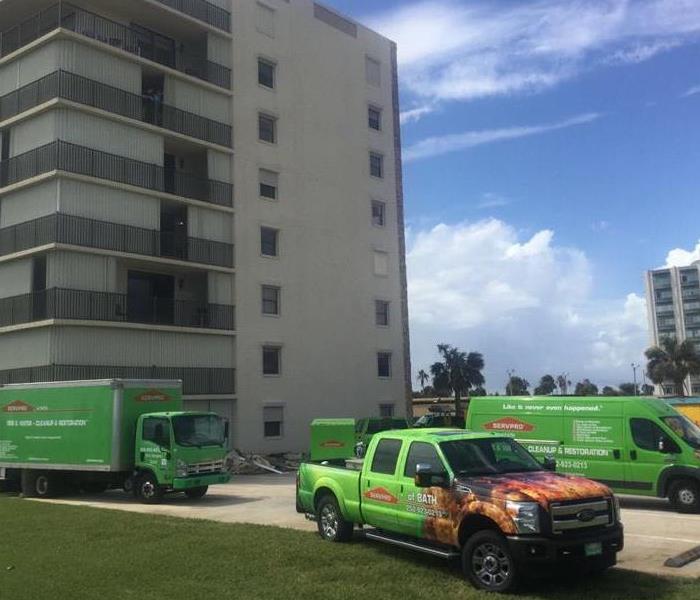 SERVPRO of Bath has help personal and commercial owners after storms.
SERVPRO of Bath has help personal and commercial owners after storms.
SERVPRO of Bath specializes in storm and flood damage restoration. Our crews are highly trained and we use specialized equipment to restore your property to its pre-storm condition.
Faster Response
Since we are locally owned and operated, we are able to respond quicker with the right resources, which is extremely important. A fast response lessens the damage, limits further damage, and reduces the restoration cost.
Resources to Handle Floods and Storms
When storms hit Eastern North Carolina, we can scale our resources to handle a large storm or flooding disaster. We can access equipment and personnel from a network of 1,650 Franchises across the country and elite Disaster Recovery Teams that are strategically located throughout the United States.
Have Storm or Flood Damage? Call Us Today 252.923.0213
Hurricane Irma now a Category 5
9/5/2017 (Permalink)
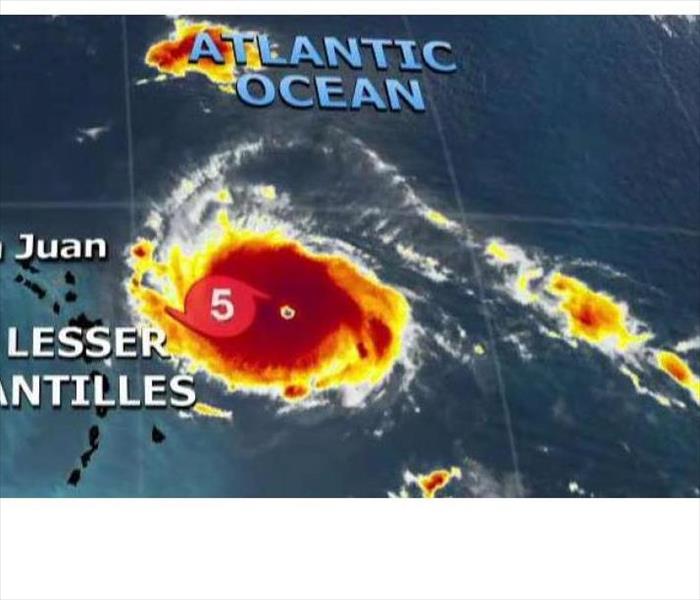 Current Path of Hurricane Irma
Current Path of Hurricane Irma
Hurricane Irma continued to strengthen Tuesday as an "extremely dangerous" Category 5 storm, prompting states of emergency in Puerto Rico, the U.S. Virgin Islands and Florida, sending residents to stores to prepare for the worst.
At this point, we do not know if the storm is going to turn northward. Even though Eastern North Carolina is very familiar with hurricanes, we need to take this storm seriously. Many of the homes in our area are built to withstand winds at 130 mph however Irma's maximum sustained winds had increased to near 175 mph.
Be sure your yard is clear of debis and/or furniture. Time to purchase tarps and check on the maintenance of your generators. Have emergency power blocks all charged for your cell phones.
"Some fluctuations in intensity are likely during the next day or two, but Irma is forecast to remain a powerful category 4 or 5 hurricane during the next couple of days," the NHC said.
Irma's center was expected to move near or over the northern Leeward Islands late Tuesday and early Wednesday before affecting Puerto Rico by Wednesday, the hurricane center said.
"Irma is now one of the strongest hurricanes we have witnessed in the last decade as a Cat 5 storm with winds of 175 mph," Fox News Senior Meteorologist Janice Dean said Tuesday.
When Hurricane Matthew hit Bertie County, SERVPRO of Bath was ready!
9/1/2017 (Permalink)
 Our highly trained crews are ready to respond 24/7 to storm or flood damage in Eastern NC.
Our highly trained crews are ready to respond 24/7 to storm or flood damage in Eastern NC.
SERVPRO of Bath specializes in storm and flood damage restoration. Our crews are highly trained and we use specialized equipment to restore your property to its pre-storm condition.
Faster Response
Since we are locally owned and operated, we are able to respond quicker with the right resources, which is extremely important. A fast response lessens the damage, limits further damage, and reduces the restoration cost.
Resources to Handle Floods and Storms
When storms hit, we can scale our resources to handle a large storm or flooding disaster. We can access equipment and personnel from a network of 1,650 Franchises across the country and elite Disaster Recovery Teams located throughout the United States.
Have Storm or Flood Damage? Call Us Today at 252-923-0213 SERVPRO of Bath






 24/7 Emergency Service
24/7 Emergency Service



















